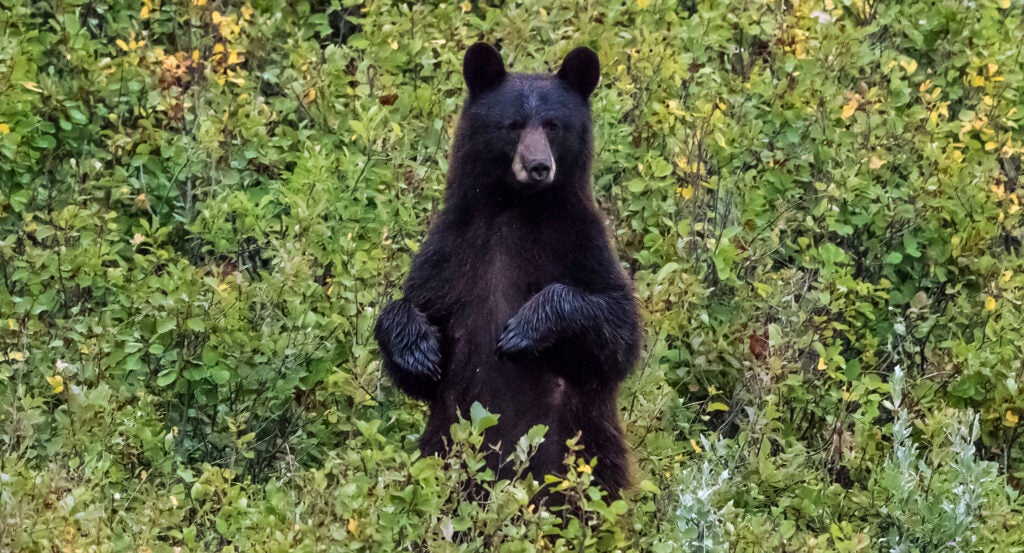You are using an out of date browser. It may not display this or other websites correctly.
You should upgrade or use an alternative browser.
You should upgrade or use an alternative browser.
Photos and videos of our amazing 2D residents
- Thread starter Bosphorus1982
- Start date
Bastian
@BastianGenicot
Des chevaux se baladent en parfaite liberté sur l’île de Nihi Sumba, au large de l’Indonésie... Comme si ce coin de nature leur était encore réservé... #cheval #horse
Horses roam in perfect freedom on the island of Nihi Sumba, off the coast of Indonesia... As if this corner of nature was still reserved for them...
@BastianGenicot
Des chevaux se baladent en parfaite liberté sur l’île de Nihi Sumba, au large de l’Indonésie... Comme si ce coin de nature leur était encore réservé... #cheval #horse
Horses roam in perfect freedom on the island of Nihi Sumba, off the coast of Indonesia... As if this corner of nature was still reserved for them...

A Relocated Bear Walked 1,000 Miles Back to Its Favorite Campsite
This bruin’s journey across four states is a reminder that hikers and campers should be extra careful with food and trash

Last week, a local broadcast news channel in Knoxville reported the story of a determined black bear that had traveled across four states to return to its favorite feeding grounds, at a campsite in Great Smoky Mountains National Park. The initial episode happened in June, when officials received complaints that a female black bear was grabbing food off picnic tables, sniffing trash cans, and even stealing backpacks. Wildlife crews trapped the animal and relocated her 1,000 miles to an area of South Cherokee National Forest in Georgia. Scientists labeled the animal Bear 609 and attached a geolocating device to it.
According to the report, wildlife biologists tracked Bear 609 as she proceeded to walk across Georgia, South Carolina, and North Carolina and then into Tennessee—eventually returning to the campsite where it had been trapped.
“This was definitely one of the most bizarre movements I’ve seen so far,” Bill Stiver, one of the wildlife biologists who tracked 609, told television station WBIR 10 News. “She never slowed down. She just kept on going.”
Stiver said the bear’s journey is the longest he’s seen among relocated individuals—typically bears will walk upwards of 200 miles to return to familiar territory, he said. Relocated bears returning to a favorite human source of food is, alas, not out of the ordinary. Public land managers often struggle with bruins that have become habituated to human food sources, like trash or unattended campsites. Adult bears will sometimes return to the scene of a break-in or encounter, or continue seeking sustenance from human sources. Often, wildlife managers euthanize adult bears that have become too dependent on humans for food. Otherwise, relocated bears are often killed by cars or humans while attempting to return to their homeland. Or, they fall victim to predators, or other bears.
Bear 609’s voyage, while impressive, is yet another reminder that hikers and campers should always be careful with food and trash when recreating in bear country. Bears have powerful noses, claws and muscles, and can easily break into cars and homes in search of grub. There are far too many sad tales of bears that were put down due to human carelessness in the outdoors. Just a few months ago, a mother and her four cubs were euthanized outside Aspen, Colorado, after they were caught entering someone’s house.
There’s one more odd wrinkle to the story of Bear 609: After returning to Great Smoky Mountains National Park, the bear ventured onward to Anderson, South Carolina. While walking through the small town, the bear came into contact with family members of one of the wildlife officials at the national park where its journey began. Lisa McInnis, chief of resource management and science at Great Smoky Mountains National Park, said her relatives sent her a photo they snapped of the bear walking across their driveway. She recognized the animal.
Border Collies having a ball (or balloon)!
Over the last 2 days in this part of Wales some birds are singing/calling as is usual at the end of December. 2 species in particular - great and coal tit. The 'teacher teacher' call of the former is quite distinctive across much of Europe.
The coal tit has a similar two-note call, perhaps best rendered as 'whit-choo, whit-choo', fwiw.
The coal tit has a similar two-note call, perhaps best rendered as 'whit-choo, whit-choo', fwiw.
Stepped out of a supermarket today to be greeted by the sound of a song thrush's rich compelling vocalisations. Really heartening to hear at this time of the year in Europe.
A Song Thrush singing at sunset in the Somerset countryside. The Song Thrush has around 100 distinct musical phrases in its repertoire. Each phrase is repeated three or four times before the bird moves on to the next one. This Song Thrush call was filmed in Somerset, UK on July 7th 2019.
maguenette
Jedi Master
maguenette
Jedi Master
Birds like to be cozy and be together
View attachment 66788
View attachment 66786
My profile pic
View attachment 66789
Part 3 :)









